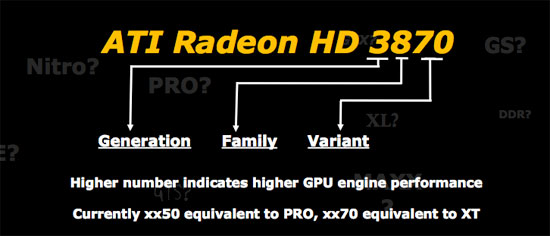ATI Radeon HD 3870 & 3850: A Return to Competition
by Anand Lal Shimpi & Derek Wilson on November 15, 2007 12:00 AM EST- Posted in
- GPUs
Sensible Naming and the Cards
It looks like we may just be seeing some of the fruits of the ATI acquisition here today; no, we're not talking about the Radeon HD 3800 series, but rather the naming of the cards. AMD is releasing two cards today, the Radeon HD 3870 and the 3850, both based off of the new RV670 GPU. Notice anything missing from the GPU names? That's right, gone are the annoying suffixes. AMD is committed to getting rid of the suffix with its GPU products, so you won't see any XT, LE, PE, FUFME, SE etc... versions of these graphics cards. Can we just say now that we think this is a great idea?
Even though the name ATI Radeon HD 3870 is still a little long for our tastes, it's still better than having confusing suffixes. As long as AMD sticks to the higher numbers means better cards methodology we're happy.
There is a method to the nomenclature madness, which the image below should explain:

The first digit is the product generation, the second digit is the family, and then the last two digits refer to performance within that family. This should sound a lot like AMD's new CPU naming system or Intel's current Core 2 family. Note that with today's launch we're already pretty high in the 3800 series, whether or not that means we'll be looking forward to a 3900 or 4000 soon is another matter entirely.
Specifics on the two cards are as follows:

The 3870 is a two-slot solution, it runs its core at a minimum of 775MHz and comes with 2.25GHz data rate memory. Despite the two-slot cooler, the 3870 is actually quieter than the 3850, which itself is much quieter than the 2900 XT.

The Radeon HD 3870
The 3850 is a single slot card, with a 670MHz core clock and a 1.66GHz memory clock. The cards are priced at $219 and $179, respectively (more on pricing later). Like the 3870, the Radeon HD 3850 is actually quiet.

The Radeon HD 3850










117 Comments
View All Comments
Roy2001 - Thursday, November 15, 2007 - link
Well, once I played games with AA enabled, I would never turn it off. I would rather lower the resolution.falacy - Thursday, November 15, 2007 - link
That's a giant "ME TOO!" for me.my old ATi 9800XT would run 4x AA at 1024x768 in most games and I found that more enjoyable than running 1280x1024 without AA. The 60Hz fliker of the monitor at 1280x1024 played a role in that I am sure, but mostly the trouble with gaming without AA is that objects in the distance tend to shimmer in an unnatural way that seems to pull me out of the moment. So, indeed lower resolution + 4x AA = a better experience than higher resolution that has distracting artifacts.
DrMrLordX - Thursday, November 15, 2007 - link
Alright, thanks. I actually overlooked the AA tests on Oblivion. Silly me.Mostly I was interested in knowing if the 3870 had better results running with 4x AA than the 2900XT. Interestingly enough, the 3870 doesn't seem to lose a lot with 4x AA, especially at high resolutions. The 8800GT is another story.
munky - Thursday, November 15, 2007 - link
But... I'd like to see more games benchmarked, and with AA preferably.StormRider - Friday, November 16, 2007 - link
Is anyone else bothered by the transistor count of 666 million? Couldn't they have done something so that it was 665 million or 667 million instead?aeternitas - Tuesday, December 11, 2007 - link
lol How stupid. As you go out using this card to obviously kill some sort of opponent, you're bothered by this?Kaleid - Friday, November 23, 2007 - link
Just a number, nothing more to it.